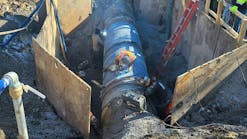The Town of Samoa in Northern California was once a bustling lumber town on the northern peninsula of Humbolt Bay. The town is also famous for the lumber camp-style Samoa Cookhouse, a staple in the community since 1893.
The Samoa Pacific Group purchased the Town of Samoa in 2001 to redevelop it by providing critical infrastructure and housing to preserve the coastal town.
The redevelopment plan includes a light industrial park, public recreation, a new single-family residential development, an affordable housing project, and overhauls to the city’s drinking water and wastewater infrastructure. Revitalizing the area is part of an effort to establish Samoa as its own official city.
The peninsula’s infrastructure, previously in place since the 1920s, was in dire need of repair. Upgrades were mandated by the California Coastal Commission and Humboldt County, resulting in the construction of a new wastewater treatment plant, along with a water storage tank in case of a power outage, earthquake, or tsunami. The effort also included a new package booster pump station for potable water distribution.
The potable water supply is routed through the storage tank to a new package booster pump station, that Romtec Utilities designed and supplied, along with the control building by sister company Romtec Inc.
The development and project management were provided by the Danco Group; infrastructure design was completed by the California Engineering Company; reviewing was done by EsGil on behalf of Humboldt County; and numerous others such as Aqua Sierra (electrical contractor) and Mercer-Frazer (contractor) constructed the booster station.
Romtec Utilities provided the developer and owner with a single source for the complete design, supply, and commissioning of this fully integrated packaged pump station and building. This offering provides significant financial value to the developer. It also helped assure the owner that, with the full backing and support of a single entity (Romtec), the system would be operational as designed.
The package booster station is designed to accommodate phased housing development and fire suppression in the community. It pulls water from an adjacent 300,000-gallon water storage tank and boosts flows for the domestic residences and fire hydrants. It is designed to meet immediate flow requirements and expected future flows using American-Marsh vertical turbine pumps.
There are three, 264-gallon tanks to prevent the system from short cycling during nuisance flow demands and suppressing transient spikes in pressure. Water pressure is maintained during power failures with an emergency generator installed inside the control building, adjacent to the pump station.
The package booster station uses a variety of Val-Matic valves, including Series 2000 butterfly valves, Series 1400 and 1800 check valves, and 15A air release valves. The station also incorporates a Ross 20WR pressure relief valve.
There are two, three-horsepower Ebara pumps for the domestic flow that pump up to 53 gallons per minute (GPM). There are also two larger, 75 HP Ebara fire flow pumps that can pump up to 1,500 GPM for high flows. The multi-stage configuration of these stainless steel pumps allows for a wide pressure capacity during the pump selection process.
Programmable pressure switches (EPS25) are installed on each pump’s inlet and outlet to ensure there is adequate suction pressure and not excessive outlet pressure. A pressure transducer by Endress+Hauser (PMP 51) monitors the pressure of the water on the system’s inlet and outlet. An Endress+Hauser flow meter (Promag L 400 Series) measures the velocity and volumetric flow rate of the water flowing through the system.
The station’s high-flow pumps include Grundfos’s vertical in-line centrifugal pumps. They use a single impeller but are designed to provide higher flow rates.
“What makes this booster station different is that it was also programmed to monitor the storage tank level and enable actuation of a fill valve,” Romtec Utilities Mechanical Engineer Kevin Bogan says. “The control panel receives a signal from a level transducer on the tank and, if the tank level is low enough, sends a signal to an actuator on the fill valve to fill the tank during specified times in the evening. Level information and valve position are also available remotely via a SCADA system.”
The control panel that Romtec Utilities designed incorporates a closed-loop control, which monitors pressure transmitters located at both the discharge and suction ends. This is to monitor the level/pressure of the supply as well as the level/pressure of the demand. As the discharge pressure decreases (showing an increase in demand) the system will begin to pump. More pumps will turn on as the demand continues to increase.
“The design is state of the art,” Dale Unea, fire chief and chief maintenance operator for Peninsula Community Services District said. “It’s all computerized, the PCL does 90 percent of the work and I just make sure everything is doing its job. It pretty much runs itself.”
The desired pressure will be maintained with PID (Proportional, Integral, Derivative) control. The use of variable frequency drives (VFD) to control the pumps is a very important process for PID control. VFDs match the speed of the pumps to optimize performance and control the build-up or slowdown of the pumps. Often used in applications in which level needs to remain constant, the VFDs will increase the power to the pumps when demand is high and decrease power when demand is low. ABB ACS580 VFDs control the speed of the pumps to output the desired discharge pressure as the water demand changes.
Some of the specific technology used on the control panel include an Allen-Bradley CompactLogix Programmable Logic Controller (PLC) that is programmed to control the entire process. It also provides operating, diagnostic, and alarms/failure information. An Allen-Bradley PanelView Plus 7 Human Machine Interface acts as the computer screen, displaying all the pertinent information within the PLC.
Finally, the station’s Cummins diesel generator is a Model 150D6D with a 150kW rating. The Cummins automatic transfer switch is an OTEC model with a 400A rating.
“It’s just the marrying of the new water system with the old, doing away with the old part of the mill system and bringing it up to date,” Unea said. “It’s bringing everything into the 21st century. The addition and phases of new homes, businesses, and revitalization of the community is what brought this full circle — and brought me on board.”
The Town of Samoa package booster station is a great example of a town investing in its infrastructure and potable water system to meet the needs of future growth and continued revitalization. WW
Published in WaterWorld magazine, August 2022.





